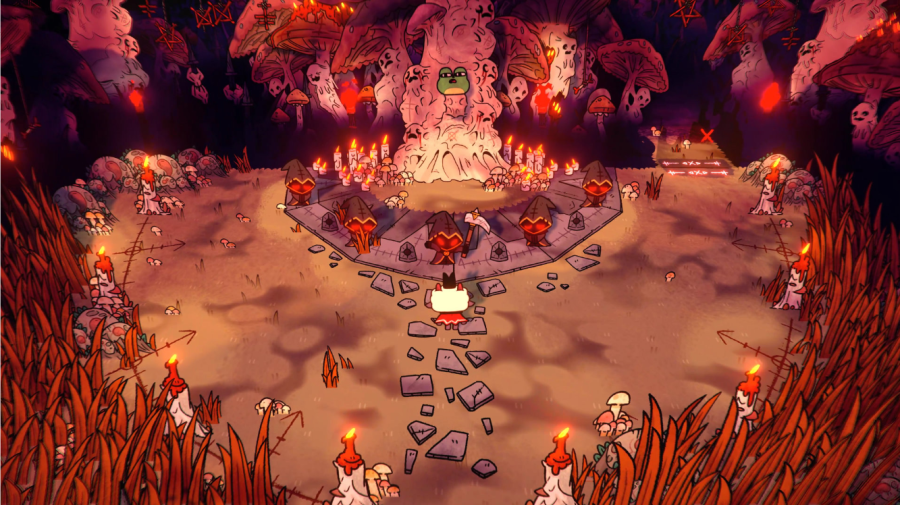Convert your Followers in ‘Cult of the Lamb’
Fight through dungeons, assemble faithful followers
Rating: APhoto Credit: Massive Monster
November 1, 2022
Amidst Cult of the Lamb’s first few minutes, players are introduced to the main character’s dilemma: being a sacrificial lamb at the hands of four bishops, trying to contain an ancient god for unknown reasons. However, just as the executioner’s axe comes down, the lamb is saved by the same exiled god, named “The One Who Waits.” In exchange for a new life, the lamb is granted a crown with a red eye, and returned to the living world to create a cult in the god’s name.
Developed by Massive Monster studio, “Cult of the Lamb” is a noteworthy experience where the player can choose their path as a merciful or cruel leader.
As the hybrid of many genres, like town-building, roguelike, simulation, and more, “Cult of the Lamb” handles the various classifications exceptionally well. It incorporates elements from The Binding of Isaac and Stardew Valley’s building and resource collecting. Because of this variation, I can easily switch from developing my town to traveling the dungeons whenever I want.
A considerable amount of this game’s charm comes from its art. Similar to the “Don’t Starve” series, the contrast between the cartoonish style and the unsettling objective of the game makes it almost deceiving for the player. In addition, the game is made of 2D aspects inside a 3D world, creating a more cartoon-like impression.
One of my favorite things about this game is sound design. Every sound effect ingame, including dialogue, fits perfectly. Like Animal Crossing’s villager dialogue, each NPC has a different style of talking without using any words, but still capturing their personality. Every sound is very recognizable, from collecting hearts for healing, or faith from a follower — even slicing grass is satisfying. The music is great for the cutely-creepy game it is.
The controls on keyboard and controller are easy to master, sticking to keys/buttons players are most familiar with (WASD and left stick). However, playing with a keyboard requires both hands on the keys inside dungeons. The “K” and “L” keys for attacking are located on the rightmost side. To some players, this could prove to be a challenge. Often, I’d reach for the mouse on instinct in these scenarios.
There is an abundance of different “Curses” ingame, making it hard to master every single one. For weapons, there are only five types ranging in speed and damage. While in the dungeons, there is an NPC named “Kudaai” that will give new weapons and curses for free. Another NPC, “Clauneck” allows the player to pull one tarot card, granting them different effects. These can apply to weapons, resources, health, etc., and stack effects when another card is pulled. This is refreshed when leaving the dungeon.
Another critical factor of the cult is “Loyalty.” Each cult member has their own loyalty level; it works as a leveling system. If loyalty with a follower becomes high enough, you will eventually be rewarded with a command stone fragment. Three command stone fragments will transform into a Doctrine, used to create new rituals.
Along with rituals and sermons is the option of sacrifice — ironic, being an ex-sacrifice yourself. But I’d find myself growing close to my oldest followers, rejecting the idea of giving them up for offering. However sacrificing followers, especially those oldest and with the most loyalty, gives large EXP into leveling up the player. As a cult leader, being too kind would mean sacrificing potential strength.
But one of my biggest concerns is the amount of time spent in the cult’s base. As the number of followers grows, it’s inevitable that resources will run short, leading to the loss of faith. Since the cult never freezes when inside the dungeons, it causes constant anxiety from the cult’s status. This is where I first decided to take a breather from the game.
“Cult of the Lamb” is an amazingly unique blend of genres. With the promise of more content, the bar of expectation rises. This game is perfect for lovers of roguelikes and town-building games looking for a challenge.
















